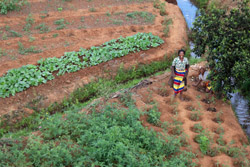Needs assessment
The most relevant agricultural water management technologies in the country which have been identified in the needs assessment, are based on their potential to satisfy the following criteria: contribution to poverty reduction, feasibility of implementation, sustainable resource use, potential for upscaling and gender and equity issues. They are the following:
- Direct seeding mulch based systems: These systems develop a permanent soil cover by associating the main crop with cover crops such as fodder crops, cowpea, rattlepods. It is practiced in alluvial soils around valley bottoms.
- Drip irrigation:
 Drip emitters are used to apply water slowly to the soil surface. It is one type of localized irrigation defined as a system where the water is distributed under low pressure through a piped network, in a pre-determined pattern. Water is applied as a small discharge to each plant or adjacent to it.
Drip emitters are used to apply water slowly to the soil surface. It is one type of localized irrigation defined as a system where the water is distributed under low pressure through a piped network, in a pre-determined pattern. Water is applied as a small discharge to each plant or adjacent to it. - Rice and fish farming: In a typical rice and fish farming system rice bunds are made high enough to retain sufficient water to grow fish. The plots have trenches and sumps, to be used as fish refuges, deep enough so there is still water for fish in dry periods.
It is to note that when farmers were asked about priority technologies for poverty reduction, the ones chosen were: surface irrigation, sprinkler irrigation, soil and water conservation measures, aquaculture and pasture.
In general, funding and the unavailability of these technologies are the most important constraints against the scaling up of these techniques.
